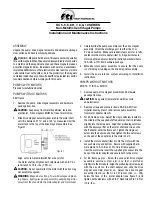
26
7.2 Pump- and motor-related faults
7.2.1 Communication faults
“communicat”
If a fault occurs in the communication via the GRUNDFOS BUS to
the units connected, the fault indication “communicat” will be gen-
erated and sent to the BUS. It appears after the respective unit in
the fault indication menu of the PMU 2000.
Possible causes of communication faults:
•
The electricity supply to the unit is switched off.
•
The BUS connection to the unit has been disconnected.
•
The communication message from the unit cannot be inter-
preted.
•
The same pump number has been allocated to two or more
pumps of the same type.
The communication fault will be suppressed (not registered) if the
electricity supply is interrupted for less than 20 secs. The fault in-
dication will appear (be registered) if the electricity supply is inter-
rupted for more than 1 minute.
7.2.2 Motor overtemperature
“motor temp”
Mains-operated motors with a I
e
up to 25 A are protected by
means of a motor starter.
Mains-operated motors with a I
e
between 25 A and 63 A are pro-
tected by means of overload relay and circuit breaker.
Additional protection by means of thermistor or winding protection
integrated in the motor.
Motor overload will release the respective overload relay. Short-
circuit will release the automatic circuit breaker that switches off
the electricity supply to the motor.
The thermistor or winding protection switch generates a fault if
the motor temperature is exceeded. The fault indication will ap-
pear 4 secs. after tripping. The pump will be switched off.
7.2.3 Frequency converter
“speed cont”
A possible fault in the frequency converter will be registered at
the PFU 2000 terminal 5. In case of a frequency converter fault,
all pumps will change over to on/off mode.
After power-up, the alarm will be suppressed for 10 secs.
7.3 Zone-related faults
7.3.1 Transmitter fault
“fault zone X sensor AIX”
If a transmitter fault is registered, the fault indication “fault zone X
sensor AI X” appears.
Transmitters with current output 0-20 mA or 4-20 mA and temper-
ature transmitters NTC 150 (0-150 °C) or NTC 50 (–25-50°C) are
monitored according to the following signal limits:
Sensor AI 1 to sensor AI 3 fault
•
4-20 mA
AI X < 2 mA or AI X > 22.5 mA for 5 secs.
•
0-20 mA
AI X > 22.5 mA for 5 secs.
•
NTC 150 and NTC 50
AI X < 0.3 V for 5 secs.
Transmitter faults disappear if the transmitter signal lies within
the fault limits for 5 secs.
Transmitters with 0-10 V output signal cannot be monitored be-
cause the total measuring range of the electronics is 0-10 V only.
7.3.2 Water shortage
“watershort”
The fault indication is “watershort”.
7.3.3 Maximum limit of actual value
“max. limit”
If the actual value is higher than the set value of maximum limit
(display 228) for more than 0.5 secs., the fault indication “max.
limit” appears.
With the control parameter “pressure”, this is the overpressure
fault.
When the actual value has been lower than the set maximum limit
for 5 secs., the actual fault condition will disappear.
For further information, see section
3.2.18 Maximum limit (overpressure).
7.3.4 Minimum limit of actual value
“min. limit”
If the actual value is lower than the set value of minimum limit
(display 229) for more than 5 secs. + start time + (2 x system
time), the fault indication “min. limit” appears.
When the actual value has been higher than the set minimum
limit for 5 secs., the actual fault condition will disappear.
For further information, see section
3.2.19 Minimum limit.
7.3.5 Any fault in the zone
If a PCU 2000 is connected to the BUS and configured, it is possi-
ble to use the relay function to indicate all faults in a zone.
For further information, see section
6.3.2 Configuration of PCU relays.
7.3.6 Fault in any motor
If a PCU 2000 is connected to the BUS and configured, it is possi-
ble to use the relay function to indicate faults in any motor.
For further information, see section
6.3.2 Configuration of PCU relays.














































